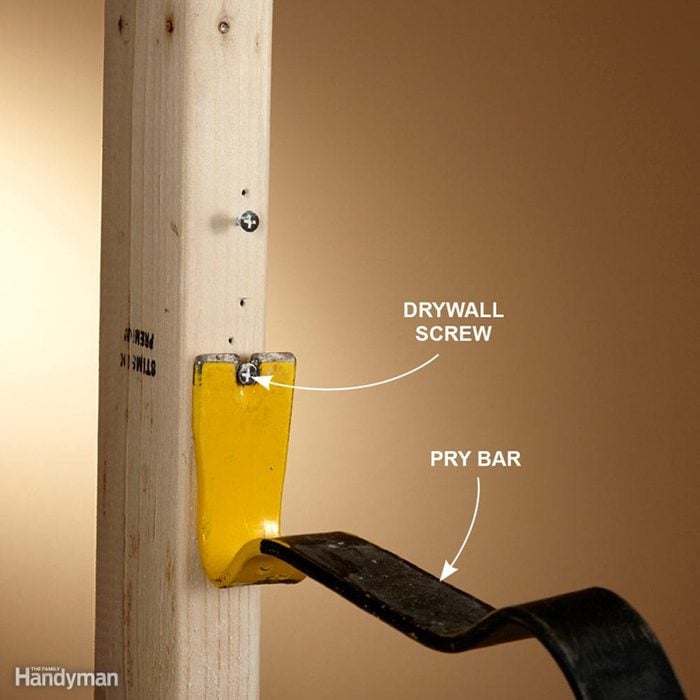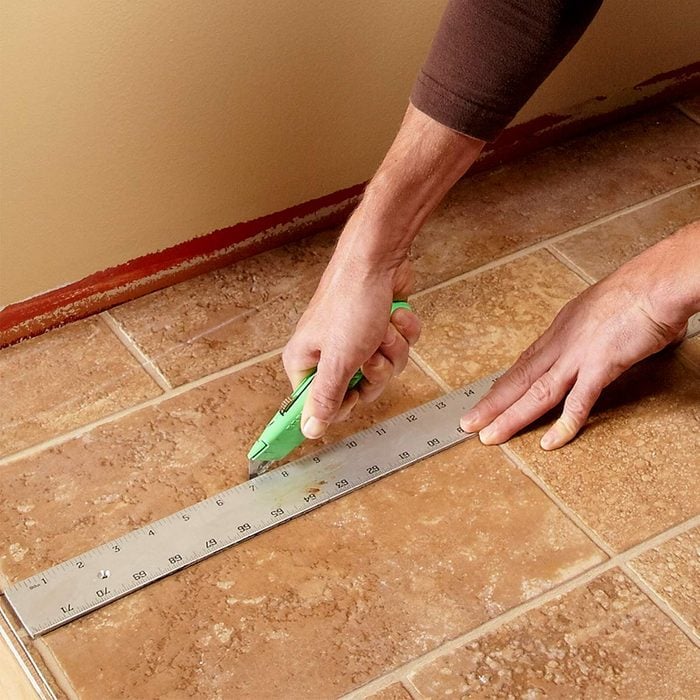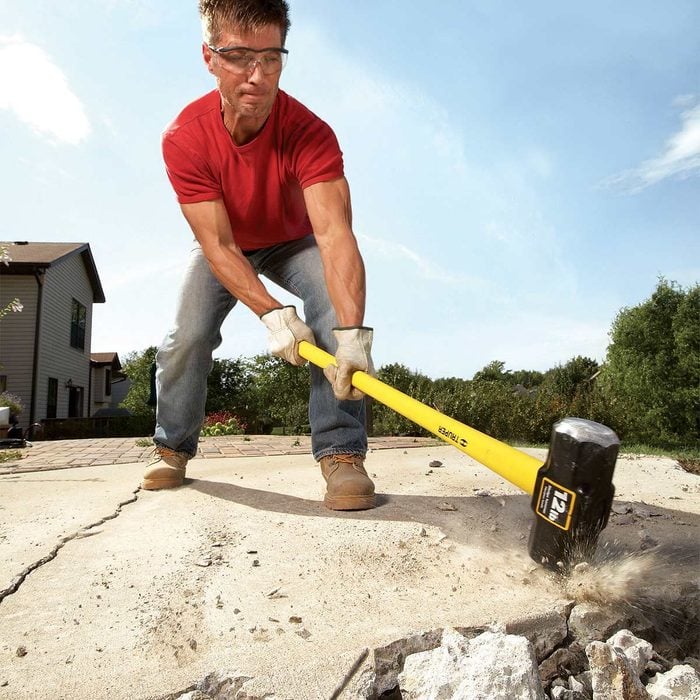
Cover Up Air Ducts

Pull Drywall Screws

Remember to Wear Safety Glasses
Since safety glasses are inexpensive, there’s no reason every DIYer shouldn’t have a pair. There are a variety of styles, including bifocal safety glasses. Wraparound glasses offer maximum protection and both anti-glare and tinted glasses are available. Keep a few pair around so there’s always one within reach.

Snip Reinforcement Wire in Concrete

Crowbars Work Wonders
Sometimes called a prybar or wrecking bar, a crowbar can be used to remove nails or as a lever to force apart objects, such as when you’re rebuilding a deck. Look for one with an ergonomic grip for easier handling.

Rent a Walk-Behind Floor Scraper

Floor Demo is Much Better with Knee Pads
If you’ve done any flooring work, you know the importance of knee pads. Knee pads are a must for your basic homeowner safety gear tool kit because they’re inexpensive and provide plenty of protection and comfort when doing everything from installing hardwood to working in the garden.

Cutting Studs

Pliers Will Come in Handy
Pliers are a must-have hand tool for any DIYer. You’ll likely need a pair of pliers for demolition projects such as removing carpet or loosening nuts, bolts and screws.

Cut It Up With a Circular Saw
Sledgehammers, pry bars and reciprocating saws aren't the only demo heroes on the job site—your circular saw can be used for a heck of a lot more than cutting studs and sheets of plywood. Fitted with the right blade, your circular saw can cut up roofing, tin, concrete, rebar, steel doors and fiber cement. With a demo blade, you can cut up nail-embedded debris all day long.

Heavy-Duty Snips are a Must
If you’re looking to cut through sheet metal, grab a pair of snips. Snips will come in handy if you’re working on replacing old HVAC ducts.

Cut Off the Nails On the Plates

Keep a Fire Extinguisher Close By
Every DIYer should have a fire extinguisher in the garage or workshop. A multi-purpose extinguisher is recommended by the National Fire Protection Association, as it is large enough to put out a small fire but still light enough to easily handle.

Cover a Concrete Slab

A Demo Fork is Invaluable
When it comes to demolition, it doesn’t get much better than a demo fork. This demo fork from Honey Badger has fangs at the end that you can slide underneath old flooring or roof shingles. Then use the long handle as a lever to pry the materials apart.
Buy a demo fork ob Amazon now.
Photo: Courtesy of Honey Badger Demo Forks

Trash Container with Gate

Removing a Door Jamb

Screwdrivers
Not all demolition work is large in scale. A screwdriver can help with delicate demolition work, such as removing and fixing electrical outlets or removing a damaged floor board.

Slice Up Drywall With a Multitool
There seems to be no end of odd jobs that can be done with an oscillating tool, and here's another one: If you have to remove a section of damaged drywall, cut it out with a multitool equipped with a half-moon blade. The tool will cut almost as fast as you can pull it. And because the oscillations on the blade are so short and the teeth are so fine, the tool creates half the dust of a reciprocating or keyhole saw. Plus, the recess you cut will be much straighter and cleaner, making the patching work much easier.

Wear a Hard Hat When Working Over Your Head
Wear a hard hat or helmet to protect your head any time you’re working with heavy objects that could fall from above. A hard hat should be worn any time you’re doing any tree maintenance such as trimming or cutting.

Demo Vinyl Flooring

Sledgehammer

Remember to Wear Work Boots
Work boots come in a variety of styles for just about every DIY project. Work boots will give you a sturdy, no-slip platform, but they should also be comfortable. If you need extra toe protection but don’t want the weight of steel-toed boots, look for boots with composite toe protection because they’re lighter.

How to Remove Carpet Yourself

Rent a Jackhammer

Sunscreen is Important When Working Outdoors
If you’re a DIYer that does a lot of work outside, keep sunscreen in your toolbox or tool belt. A spray or stick sunscreen is quicker and easier to apply than lotion-based versions. Follow these 10 summer safety tips to stay safe and cool in the sun.

Knock Out Studs Sideways
A sledgehammer works great for busting up studs, but don't take a whack at the middle of the studs—they'll just wobble back and forth and probably bounce the head of the sledge right back in your direction. Hit the studs as close to the bottom plate as you can, but not so hard that you pull out the nails on the top plate—that's a good way to catch a falling stud in the noggin. Hit the bottom of each stud just far enough to dislodge it from the nails that were holding it. Then grab hold of it and pull it off the top plate.

Tear Off Roof Shingles Yourself

Pull Nails With a Nipper
If you're replacing windows, doors or flooring and you want to salvage the trim, end-nipper pliers are a handy tool to pull out brads and finish nails. The rounded end provides plenty of leverage, and if the nail breaks, you can always cut it down flush. Don't squeeze too hard when gripping the nail or you may nip it off prematurely.

Drive Dust Outside With a Fan

Cut the Jamb and Pull
You can knock a jamb sideways out of its opening, but the nails or screws holding it in place put up strong resistance to the shear force you apply.
An easier way is to cut one of the sides in half with a reciprocating saw and then pull the rest straight away from the framing. You can easily pull away any nails or screws holding the doorjambs in place simply by using the leverage of the jamb itself. Make your cut at an angle so the two cut sections don't wedge against each other, preventing you from pulling them apart. This same technique works for pulling out windows.

Cut Fiberglass Surround Into Pieces

Hearing Protection is a Must
When it comes to hearing protection as part of your safety gear toolkit, earmuffs provide the most protection from loud power tools and outdoor equipment, while earplugs are less restrictive and can easily be stored in your pocket. Here are some tips to choose the best hearing protection for your needs.

Save Time
Cast iron tubs are ridiculously heavy. So unless it's a priceless collector's item, you don't want to have any part of moving one. Your best bet is to bust it up in place. It can be tough to get the cracking started, so begin hitting the tub at the edge. Once it does start breaking, pound your way along the smashed edges.
Throw a tarp or thick sheet of plastic over the top to cut down on flying shards of iron. And wear your safety gear, especially hearing protection—busting up a cast iron tub is like having a front row seat at a church bell convention. This tip works on just about anything brittle: old toilets, radiators, concrete laundry tubs, etc.

Use the Right Blade
- For cutting through metal pipes and nails, use a fine-tooth blade resembling a hacksaw.
- When cutting through wood, use a coarse blade.
- Use the coarsest-tooth blade to cut through plaster.
- Some blades are toothless. They're coated with tungsten carbide abrasive grit; use them for cutting stone, ceramic tile and cast iron when doing work like kitchen demolition.

Suck Out Insulation
Tearing down a drywall ceiling is not a super-pleasant experience, but tearing down a ceiling that has 14 in. of blown-in insulation on top of it is a complete nightmare. Avoid that gigantic mess by sucking out all the insulation in the attic before pulling down any drywall.
The huge vacuum required for the job costs about $220 a day to rent, but if your local rental center doesn't carry them, call an insulation contractor in your area. Many blow-in insulation installers also have the equipment to suck out the insulation. But this service isn't cheap: Expect to pay about $1 to $1.50 per sq. ft. You might be able to get a deal if you use the same company to blow in the new insulation. Make sure your insulation is fiberglass or cellulose. If you even suspect there's vermiculite insulation in the attic, get an expert opinion before touching the stuff—it could contain asbestos.

Cut Around the Window With a Recip Saw

Reciprocating Saw: The Best Demo Tool Ever!

Discovering and Removing Mold
- Wear old clothes and shoes that you can launder or throw away after the cleanup work.
- Wear special N-95 or P-100 respirators, in addition to goggles and gloves.
- Set an old box fan or a cheap new one in a window to ventilate the room while working. Throw it out when you’re done cleaning, because the spores are almost impossible to clean off. Tape plywood or cardboard around the window openings so the spores can’t blow back in.
- Wrap and tape moldy carpeting in 6-mil plastic, and double-bag mold-infested debris in garbage bags for disposal.
- To control airborne spores, moisten moldy areas with a garden sprayer while you work.
- Turn off your furnace and air conditioner and cover ducts and doors to contain spores.
- Keep your wet/dry vacuum outside when you vacuum.

Jackhammer Technique

Don’t Forget Comfortable, Durable Gloves
Gloves are a must-have when it comes to safety gear, whether you’re working in the garden, on the gutters or in the garage. Leather, canvas and cloth gloves all offer plenty of protection, but should still be comfortable.

Remove Trim with Minimal Damage

Power Wheelbarrow

Masks and Respirators are Extremely Important
Dust and toxic airborne particulates are often thrown into the air when doing DIY work like kitchen demolition, so at the minimum, keep a dust mask handy. Dust masks should have the N95 certification which will ensure the dust will stay out of your lungs. A respirator mask is a must-have safety precaution when you’re doing your own demolition work.

Remove Tile from a Concrete Floor

Determining a Load-Bearing Wall

Rip Hammer

Take Out a Toilet

Keep a First Aid Kit Close
No matter how careful you are, there will likely come a time when you or someone you’re working with will need first aid during a project. Keep a kit stocked with bandages, adhesive tape, gauze and an antibiotic ointment. Make a second kit to keep in your car.

